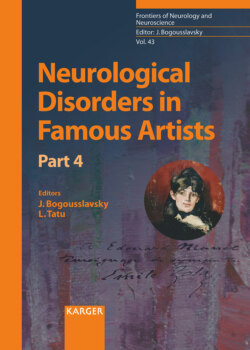Читать книгу Neurological Disorders in Famous Artists - Part 4 - Группа авторов - Страница 20
На сайте Литреса книга снята с продажи.
The Irascible Eighteen
ОглавлениеAbstract expressionism can also be seen as a form of protest against the established art world. This was reflected in the open protest initiated by abstract expressionists which was fuelled by the Metropolitan Museum of Art [Larson, 2002]. This institution decided to support young and emerging modern painters by organising a national juried exhibition entitled “American Painting Today, 1950.” In response, abstract expressionists gathered together at Adolf Gottlieb apartment in Brooklyn and drafted a letter of protest, which was printed on the front page of the New York Times (May 22nd, 1950) with the following headline: “18 Painters Boycott Metropolitan: Charge ‘Hostility to Advanced Art’” [Larson, 2002].
The artists stated they would not submit their work to “the monster national exhibition” and they expressed their concern that based on the choice of jurors the likelihood of advanced art inclusion into this exhibition would be minimal. This letter attracted wide attention and, in the editorial published in the Herald Tribune on May 23rd, 1950, which accused the authors of the distortion of facts, the group was branded “The Irascible Eighteen.” Following the public interest in this conflict, Life magazine published a photo taken by Nina Leen of “The Irascibles” in its edition of January 15th, 1951 (Fig. 1). Of note is the fact that three original signatories of the protest letter were not present in it, namely Weldon Kees, Hans Hoffmann, and Fritz Bultman [Alloway and MacNaughton, 1995; Larson, 2002].
Following this protest, the artists continued their individual production and they took over lower Manhattan within the area bounded by 8th and 12th Street between First and Sixth Avenues as their artistic cradle, spending hours in local cafeterias discussing art and life. They continued their artistic activities in local studios, including Jackson Pollock’s studio on East 8th Street, Willem de Kooning’s and Philip Guston’s on East 10th, and Franz Kline’s at the Cedar Street Tavern on University Place [Moma.org, 2018]. They soon started selling their paintings on a larger scale at rising prices, and some became the most expensive living painters.
Behind the spectacular success of abstract expressionism there lies individual cost and dysfunction. The “irascible” tag synonymises touchy, grumpy, and irritable, pointing towards possible mood and/or personality disorders. Schildkraut et al. [1994] analysed the prevalence of psychiatric disorders in 15 New York abstract expressionists, most of whom can be seen in Figure 1. The authors suggested that artistic creation in abstract expressionists was based on psychic automatism, which involves involuntary actions that are not controlled by the conscious mind. The artist would translate subconscious content through these automatic functions using free associations into abstract art heavily loaded with spiritual and psychological elements. This subconscious drive would originate from the archetypal themes of life, death and creation. Schildkraut et al. [1994] found that more than half of New York expressionists suffered either mood disorders, preoccupation with death, or alcohol abuse. This is a very interesting finding in the light of the origin of abstract expressionism in the post-war era, characterised by global humanitarian crises, the deprivation of values, and pressures from Cold War politics. The other interesting findings from the abovementioned analysis are that almost half of abstract expressionists sought psychiatric treatment and 20% of them required hospitalisation due to psychiatric problems. Their life spans were shorter on average, as two artists committed suicide, two died in a car accident when at the wheel, and overall seven died before the age of 60 years. Schildkraut et al. [1994] postulated that depression led abstract expressionists to inward thinking and questioning of the purpose of living and dying, which subsequently confronted them with the existential dilemma of the sense of life and death. Confrontation with this existential mystery would give the basis for tragic and timeless art denuded of any form and references [Schildkraut et al., 1994].
Fig. 1. Portrait of “The Irascible Eighteen.” Nina Leen (photographer), November 24th, 1950, Time Life Pictures/Getty Images. Front row: Theodoros Stamos, Jimmy Ernst, Barnett Newman, James Brooks, Mark Rothko; middle row: Richard Pousette-Dart, William Baziotes, Jackson Pollock, Clyfford Still, Robert Motherwell, Bradley Walker Tomlin; back row: Willem de Kooning, Adolph Gottlieb, Ad Reinhardt, Hedda Sterne. Reprinted with permission.
Exploring further the presence of disease in this group of artists, it is important to mention that two painters from “The Irascible Eighteen” group – James Brooks and Willem de Kooning – were diagnosed with dementia. Another abstract expressionist artist of Canadian descent, Agnes Martin, who came to New York in late 1950s, was diagnosed with paranoid schizophrenia and dementia in her very late years. In the next part of this chapter we will focus on the lives and artistic creations of these three artists.
